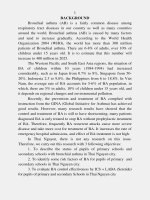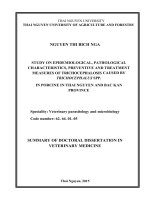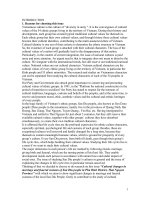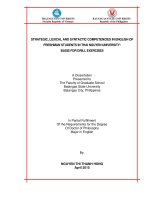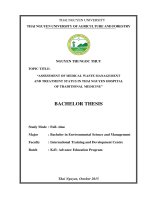Customer Behavior, Emotional Labour, and Employee’s Emotional Outcome in Hotel Industry in Thai Nguyen Province (2)
Bạn đang xem bản rút gọn của tài liệu. Xem và tải ngay bản đầy đủ của tài liệu tại đây (370.55 KB, 16 trang )
1
CUSTOMER BEHAVIOR, EMOTIONAL LABOUR AND
EMPLOYEE’S EMOTIONAL OUTCOME IN HOTEL INDUSTRY
IN THAI NGUYEN PROVINCE
EXECUTIVE SUMMARY
CENTRAL PHILIPPINE UNIVERSITY
DOCTOR IN BUSINESS ADMINISTRATION
MAI VIET ANH
DECEMBER 2016
2
EXECUTIVE SUMMARY
Customer Behavior, Emotional Labour, and Employee’s
Title:
Emotional Outcome in Hotel Industry in Thai Nguyen Province.
Total No. of Page: 107
Researcher:
Mai Viet Anh
Degree Program:
Doctor of Management
Institution:
Central Philipine University
Jaro, Iloilo City
Region VI
Background and Rationale of the Study
One of the typical characteristics of services is that customer and employee may
together affect the service quality. Each customer with his/her different needs and
wants may evaluate the service quality differently. The interaction between employee
and customer also affects service quality and customer satisfaction. Because service
quality depend on employee’s feelings when they provide service, employees’
emotions in service encounter are very important to service transactions.
In Thai Nguyen province, many service firms face with difficulty that
sometimes employees have to deal with unpleasant customers and they easily get
angry. In some cases, employees do not show their suitable emotional expression that
cause customers dissatisfied with services and switch to other providers. In some
situations, employees’ negative emotions cause by customer behaviors. However,
employees do not control their emotional and react in impolite way may cause
situation worse. Many service firms in Thai Nguyen province do not pay attention to
this problem. These situations seem to be true with several hotels in Thai Nguyen.
Because of unsuitable emotional expression in some situation, employees may make
customers feel dissatisfied with services. Understanding deeply the mechanism of
emotional regulation and its outcomes may help hotels increase customer satisfaction
and retention.
3
Research Questions
- Customer injustice behaviors have impact on employee’s emotions or not?
- What is the effect of employee’ emotions on their emotional labor or
emotional regulation?
- What is the effect of emotion regulation on employee’s emotional outcomes?
Objectives
1)
To study and clarify the effect of customer injustice behavior on
employee’s emotion in service process.
2)
To study the effect of employee’s anger felt on emotional regulation.
3)
Identify the effect of emotion regulation on employee emotional
outcomes such as emotional exhaustion and job satisfaction.
Hypotheses
H1: Customer injustice behavior will lead to anger feeling in employees
H2: Anger feeling will cause employees to engage in cognitive reappraisal
strategy to regulate their emotions.
H3: Anger feeling will cause employees to engage in emotion suppression
strategy to regulate their emotions.
H4: Employees who engage more in cognitive reappraisal strategy will more
satisfy with the job
H5: Employees who engage more in cognitive reappraisal strategy will less
become exhaust
H6: Employees who engage more on suppression strategy will become exhaust.
H7: Employees who engage more on suppression strategy will less satisfy with the
job
Customer’s
Injustice
Behavior
Employee’s
Anger Felt
Cognitive
Reappraisal
Job
Satisfaction
Emotion
Suppression
Emotional
Exhaustion
4
Significance of the Study
By conducting this research, managers at Hotels in Thai Nguyen can
understands the mechanism of emotional regulation in employees, understand the role
of emotional regulation in service process. By training employees with emotional
regulation skill, hotels can avoid some situations in which employees show their
unsuitable emotions with customers, increase customer satisfaction and retention.
Research Design
A common service scenario will be designed that would provoke emotional
responses in employees. Participants will be surveyed in groups of around 30-50
people. They will be asked to engage in a role-playing exercise that they imagine they
experience the situations in which they are treated with injustice behaviors. The
particular procedure will be as followings:
Population, Sample Size, Sampling Techniques
Population
The target population of this study will be employees who work in Hotel
Industry in Thai Nguyen province.
Sampling Technique
The sample size will be 385.
In this study, twenty (20) hotels with over 30 employees for each will be chosen
to take the survey.
Research Instruments
Four items (7-point scale) used for measure employees’ emotions (anger) after
being treated unfairly will be adapted from Bougie et al. (2003) and Weiss (1999).
Angry feelings will be assessed with four items (7-point scale): angry, enraged,
frustrated, and irritated. Scores on these four items will be summed to form an anger
experience composite, which is the score used in analyses. Two items adapted from
Rupp et al. (2008) and two others from Colquitt (2001) will be used to measure
employee perception of customers’ interactional injustice (7-point scale). Five items
for measuring cognitive reappraisal and three items for measuring emotion suppression
(7-point scale) will be adapted from Gross and John (2003) and Gabbott (2010). In
5
order to measure job satisfaction, this study uses four items adapted from Schwepker
(2001). Table 1 indicates all items and constructs used in this study. Seven items will
be used to measure employee exhaustion adapted from Maslach, et al., 1996.
Data Gathering Procedures
First, the scenario and questionnaires will be prepared. And then, these two
instruments will be validated by some researchers in Thai Nguyen University of
Economics and Business Administration. After revising the questionnaires from
researchers, the revised questionnaires will be used in pilot test. From the results of
pilot test, the questionnaire and scenario will be corrected and modified before taking
the official survey. The questionaire before using for survey was translated into
Vietnamese and then the Vietnamese version was translated into English
independently.
Date Processing and Data Analysis
The data after collection will be analyzed through following procedures:
Descriptive Statistic Methods
Descriptive analysis to eliminate some errors of scales by comparing mean,
distribution plot, maximum and minimum values. The data will be checked for data
input errors.
Purification Process
The data after taking some descriptive methods will be purified by some
methods:
Exploratory Factor Analysis
Scale Reliability Testing
The scales will be checked through reliability analysis to assure the convergent
and reliability. Cronbach’s Alpha will be used to test the reliability of scale. This
coefficient allows assessing the consistency of scale that represent for the variable. In
this study, the reliability of scale through Cronbach Alpha must be greater than 0.7
with sample size of 300. The Item-total Correlation must be greater than 0.4.
6
Preliminary Analysis
In an experimental–designed study, validity of the scenario-based approach is
very important. Two issues should be concerned with a role-playing based study are
realism of scenario and easiness of role-playing. When the experimental designed
study lacks either of the two, the interpretation of the results may become problematic.
The results showed that the scenario was shown to be a realistic and easy situation for
the subjects to imagine themselves as employees in.
Scale Purifications
In this section, the processes for assessment of measurement quality are
presented. Exploratory factor analysis was conducted to examine a factor loading and
item-total correlation of an indicator for each of seven constructs in the hypothesized
model. Then, the reliability of each construct was investigated. Some items have factor
loading values less than 0.4 or high cross-correlation with other indicators, or low
item-total correlations were deleted. If the construct shows low level of reliability with
Cronbach Alpha less than 0.6, it was also deleted. The results of exploratory factor
analysis for each construct were as followings.
Hypothesis Testing
Hypothesis 1. This hypothesis is that customer injustice behavior will lead to
anger feeling in employees. The confirmatory factor analysis showed that perception
of customer injustice behavior has a positive effect on anger felt in employee with
β=.72 (p < .01). The hypothesis 1 was supported.
Hypothesis 2. This hypothesis is that Anger feeling will cause employees to
engage in cognitive reappraisal strategy to regulate their emotions. The confirmatory
factor analysis showed that after experience anger felt, employees engage more on
cognitive reappraisal β=.41 (p < .01). The hypothesis 2 was supported.
Hypothesis 3. The results from confirmatory factor analysis show that the
hypothesis H3 is supported. It means that employees who feel angry with customer
injustice behavior engage more on emotional suppression (β=.58, p<.01).
Hypothesis 4: This hypothesis stated that employees who engage more in
cognitive reappraisal strategy will feel more satisfied with the job. The results from
confirmatory factor analysis support this hypothesis (β=.39, p<.001).
7
Hypothesis 5. The data analysis showed that employees who engage more on
suppression strategy will less satisfy with the job. This hypothesis was not supported
with t-value of 1.411 and p-value of 0.159.
Hypothesis 6: The data analysis also supported this hypothesis. It means that
employees who engage more on suppression strategy will become more exhaust. The
results from confirmatory factor analysis support this hypothesis with (β=.19, p<.001).
Hypothesis H7: This hypothesis stated that employees who engage more in
cognitive reappraisal strategy will more become exhaust. The results from data
analysis show that cognitive reappraisal has positive effect on emotional exhaust with
(β=.18, p<.001).
Table 4.12. Summary of Hypothesis-Testing Results
Hypotheses
Results
H1: Customer injustice behavior will lead to anger feeling in
Supported
employees
H2: Anger feeling will cause employees to engage in
Supported
cognitive reappraisal strategy to regulate their emotions.
H3: Anger feeling will cause employees to engage in emotion
Supported
suppression strategy to regulate their emotions.
H4: Employees who engage more in cognitive reappraisal
Supported
strategy will more satisfy with the job
H5: Employees who engage more on suppression strategy
Not supported
will less satisfy with the job
H6: Employees who engage more on suppression strategy
Supported
will become exhaust.
H7: Employees who engage more in cognitive reappraisal
strategy will become exhaust
Supported
8
Confirmatory Factor Analysis Results
.39
Customer
Injustice
Behavior
.73
Employe
e Anger
Felt
Deepacting
(Reapprais
al)
.19
Exhaustion
.39
.16
.48
SurfaceActing
(Suppressio
n)
Job
satisfaction
.18*
Findings
The objective of this study is to identify the relationship between the
independent variable which is the customer injustice, employee anger felt, employee
emotional regulation and the outcomes. Emotional regulation consists of two strategy
cognitive appraisal and emotional suppression with the dependent variable which is
the outcomes that consists of job satisfaction and emotional exhaustion. The result of
each hypothesis will be compared with the previous research or literature to confirm
whether this research result is accepted with other researcher literature.
This study addressed an important issue that has received much attention in the
research literature: the interaction between customer and employee in service.
Although previous research studied the effect of managerial factors affecting
employee’s mood and emotions, the current study went further by identifying the
effect of customer injustice behavior on employee’s emotions emotional outcomes.
This research also clarified the concept “emotion regulation” and analyzed the effect
of emotion regulation on employee’s outcomes. By analyzing the effect of customer
injustice behavior on employee ‘s emotions and outcomes, this study interpreted the
phenomenon employees get into stress when they interact with customers.
The results show that customer injustice behavior will lead to anger feelings in
employees. When employees were treated unfairly by customers, it is easy for them to
get angry. As predicted, in cases of more customer injustice, employees engaged in
higher levels of anger felt. In the service industry, customers are indeed an important
source of injustice in the workplace. Our results therefore serve to extend the multifoci
9
model of organizational justice (Cropanzano et al., 2001), making the case for
customers a source of injustice. The research in human resource management focused
on study the feelings of employees with organizational factors. Employees may feel
angry with their bosses or their coworkers. Not much research focus on customers as a
source of anger felt. Customers with injustice behaviors may make employees feel
angry.
The findings from data analysis also show that when employees suffer from
anger felt, they will use suitable strategies to cope with anger felt. Because of
organizational rules, employees try to control their emotions during service process.
As above discussion, emotion regulation refers to the processes by which people
manage their emotions to response to the stimuli and seek to redirect the spontaneous
flow of their emotions. This process consists of two sub-processes. Employees in
service firms also experience from this process. Four of these are involved in deep
acting process and response modulation involves surface acting. To deal with negative
emotions, employees must adopt some coping strategies. In this case, they apply
cognitive reappraisal strategy.
When employees suffer from being treated unfairly by customers, they intend to
behave naturally in ways that help them to release the stress. However, in service
process, they cannot show their anger expression because of company’s rules. Even
though they are really angry, they try to suppress their anger to achieve customer
satisfaction. The results from data analysis support this hypothesis. This hypothesis
consistent with following studies:
Morris and Feldman (1996) predicted that when the emotional response desired
was positive, positive affectivity would reduce the amount of emotional dissonance
present. Others have proposed that negative affectivity, on the other hand would
increase the amount of emotional dissonance in that situation (Abraham, 1998). Given
that emotional dissonance is a direct result of surface acting, these predictions
essentially assert that positive affectivity will reduce the need or frequency of surface
acting, and negative affectivity will increase the frequency of surface acting.
Emotional suppression can be considered as surface acting in employees.
10
The relationship between cognitive strategies and job satisfaction shows
positive results. The results analyzed in the chapter 4 shows that there is a positive
relationship between cognitive reappraisal and job satisfaction. The relationship
between these two variables is significantly with strong relationship. As we know that
cognitive reappraisal is process of regulating emotion for intentional purpose.
However, this process can help employees reduce the effect of emotional events on
their emotional state. Therefore, they seem to feel more satisfied with job when
adopting this strategy.
Emotional exhaustion occurs when the emotional demand exceed what an
individual is able to afford during interpersonal interaction at work (Maslach,
Schaufeli & Leiter, 2001). When an individual chronically works under stress that is
induced by interpersonal interaction, emotional exhaustion can further result in
emotional over tension. Because of the stress raising during service process and cause
by unfair treatment of customers, employees seem to be exhausted and they seem to
less satisfied with their job.
The regulation of emotion can help employee to display positive emotion.
According to Diefendorff and Gosserand (2003), employees involve in emotional
labor to influence the emotions of others so that work goals can be achieved. This
study adds to the growing literature on to sightsee the relationship of emotional
suppression and the outcomes.
Emotional labor can result in emotional exhaustion in long term. For example,
the relationship between employee emotional labor and emotion exhaustion.
Emotional labor in overall stated a positive correlation with emotion exhaustion. The
means that when emotional labor is strongest, the high the emotion exhaustion (Kruml
& Geddes, 2000). Previous studies show that the relationship between emotional labor
and job satisfaction can be mutual since job satisfaction is believed to influence
employee performance (Hallowell et al., 2003). Thus, emotional labor, an employee
performance indicator, can also be expected to be influenced by job satisfaction. The
other previous research suggests a direct relationship between emotional labor and
emotion exhaustion. For example, according to Hochchild (1983) display emotion that
11
are appropriate in a given situation and expressing these emotion may cause alienation
from one feeling and it thereby contribute to emotional exhaustion.
In service process, when employees got angry, they can keep calm by change
the way thinking about the events. Deep acting has strongest relation for predicting
emotional exhaustion. In particular, when the flight attendance realize that the
company always responds to customer complaints by supporting the client rather than
the employee, the degree of deep acting is likely to increase. Therefore, airlines should
consider carefully how to decrease their employees’ feeling that they must engage in
deep acting; they should also consider more carefully their treatment of employees,
and whether they should be more understanding and tolerant of employees.
Managerial Implications
This study reveals that consequences of emotional labor can be either positive
or negative, depending on how the emotional labor is performed. Therefore, emotional
labor cannot be predictable. In this thriving economic, Dibble (1999) stated that
employees are the most important asset in the organization. Emotions are
quintessential to human experience, which influences man thought and action. In the
past, Grandey (2000) said that emotion in work place is believe to hide sound
judgments and thus were not perceived as workplace phenomena. The management
should create the environment for the workers so that the workers can motivate
themselves and be comfortable with the environment.
Because firms do not really understand the quality of service and customer
satisfaction therefore not aware of the role of emotions and attitudes of employees in
the process of providing services to the huge influence customers’ satisfaction. This is
an important factor in enhancing the quality of services so business owners must focus
on this work.
These studies help manager to overcome emotional labor problem. Employee
now days are having problem in displaying their emotions. In order to overcome the
problem, managers can screen employees by exposing them to stimulated situation to
deal with problem. This kind of alternative can guide the employee to display emotion
appropriately. Manager can also reduce burnout problem through job rotation. Burnout
12
has to be prevented because it can lead to stress and unbalanced employment in the
organization.
In order to help employees to get skills to control emotions while working,
business owners must recruit appropriate employees. Employees who directly provide
services not only should be good at knowledge but also good at emotional intelligence.
Therefore, the selection process should be directed to select qualified employees with
high level of emotional intelligence. These are people who have the ability to regulate
their emotions better than others are so appropriate for working at customer contact
positions or directly provide services.
Training for Employees
Service providers need to be courteous to customers. However, customers have
no obligation to return empathy or even courtesy. In some situations where customers
exercise the privilege of “customers are always right,” service providers face real
challenges suppressing their true feelings. It is critical for both employees and
organizations to learn how to deal with such situations.
In the service industry, the focal point for most of the training programs is on
the customer’s feelings—how to make them feel comfortable and welcomed. These
types of training are given intensively to recently hired employees. An important
component of orientation programs is to convey appropriate attitudes and display rules
to the new employees. Very few training programs are designed to discuss how
service employees feel. However, as employees accumulate different experiences on
the job, it is equally important to discuss line employees’ feelings.
Openly discussing the frustration on their jobs is a cure to heal employees’
wounds when they are hurt or insulted by customers. This type of training has several
effects. First, it delivers a message to employees that the company is aware of and
acknowledges the emotional contribution that employees put into jobs. This positive
feedback can motivate employees to increase their productivity and be more
committed to their jobs and organizations. Second, it provides an opportunity to
ventilate employees’ negative emotions caused by their jobs. Third, by implementing
this type of training, companies can develop in their line employees the ability to
suppress anger or avoid frustration. Hochschild (1983) recorded the discussion of a
13
trainer in such a training program. This trainer said: “If a passenger snaps at you and
you didn’t do anything wrong, just remember it’s not you he is snapping at. It’s your
uniform; it’s your role as a Delta flight attendant. Don’t take it personally” (p.110).
With this type of training, focusing on line employees’ feelings, both line
employees and managers can talk over the negative emotions and trade tips about the
least offensive ways of expressing them. If companies do not provide formal or
informal ways to ventilate employees’ anger and frustration, sooner or later, line
employees will express anger to their customers.
Another focus of employee training is on the deep acting technique. One of the
significant findings of this study is that deep acting is a critical factor in determining
the consequences of emotional labor that service employees experience. Considering
the positive effects that deep acting can bring forth to organizations (i.e., increased
customer satisfaction and employee job satisfaction), it is worthwhile for companies to
invest in this type of training to teach employees how to “feel” in certain ways that
help them reach organizational goals.
Deep acting can be achieved through changing focus and reappraisal of the
situation. Changing focus is one way employees can learn to evoke certain feelings. It
can be done by actively thinking about events, which call up the desired emotions.
This is also known as method acting. For example, employees can think about a funny
movie to evoke cheerful emotions. By learning how to direct one’s attention,
employees can practice skills to prompt or suppress certain emotions at will.
Another deep acting technique is to cognitively reappraise the unpleasant
situation so that the emotional impact is lessened (Grandey, 1999). Researchers have
found that the ability to reappraise the situation is an effective way to cope with stress
(Folkman & Lazarus, 1991). Employees can learn how to use an “as if” supposition to
reevaluate the same incident in a different way. For example, Hochschild (1983)
described flight attendants who are trained to think about difficult passengers as
hungry children so that they won’t get angry with them. By integrating deep acting
into employee training programs, the internal processes of emotional management are
carefully regulated and external emotional expressions seem to be more genuine and
spontaneous.
14
Training for Managers
Line employees are not the only people performing emotional labor. Managers
do a great deal of emotional labor as well. Two major tasks of a manager’s job are to
deal with customers and to deal with employees. Dealing with customers takes
emotional labor. Dealing with employees requires even more emotional labor.
Managers’ role is similar to that of the director of a show. They monitor, control, and
direct the emotional labor their cast members perform for customers. Hochschild
(1983) commented on supervisors’ role in monitoring emotional labor. She said:
“What is offstage for the line employees is on-stage for the supervisor” (p. 118). It is
the managers’ responsibility to ensure that their cast members are in the best condition
to perform.
As a result, an organization needs to train their managers or supervisors how to
perform emotional labor when interacting with their employees. Training modules,
such as “how to provide emotional support,” “how to handle employee complaints,”
“how to provide feedback,” and “constructive opinions,” should be integrated into
formal management training programs.
With current employees, it should be increased the exchanges to share
experience to understand the skills workers balance their own feelings. Employees
with low emotional intelligence should be trained to learn the skills to control
emotions so that they can control their emotions. The skills are:
+ Attention deployment. This is the skill is to orient the thinking to the other
events. Employee may redirect the thinking to other things to reduce the pressure from
negative emotional stimuli. For example, an employee serves a discerning client and
causes many negative emotions. This employee can direct his attention to other things
such that think about going shopping after the working hours to reduce pressure from
stimuli.
+ Cognitive Reappraisal. When an employee serve a discerning client, he may
be angry because of customers, but he can control his emotion by thinking about other
directions such that meeting this customer is just unlucky.
Organizational Rules: Service companies need to have clear rules about
behavior and emotions of staff to clients. Along with training and retraining, service
15
enterprises must have clear rules about how behavior when providing services to
customers. The inappropriate attitudes or emotions can make customers dissatisfied
and then that has a large impact on business performance. The rules of the company
are to force employees to control personal instinct or momentary anger to achieve
customer satisfaction. Service firms should have some training programs to help
employees know how to control their emotions.
16
CONCLUSION
Emotional regulation at work is a new field of human resource management.
Feelings of employees during the service providers are very important for service
firms. Employees do not control their emotions can get angry themselves, affect
customer satisfaction and affect the quality of service. Understanding the mechanisms
as well as factors affecting the feelings of employees from offering solutions will
improve the skills of employees that makes the interaction between customer and
employee more efficient.
The findings from this study indicate that when employees interact with
customers during service process, their emotions are affected by customer behavior. If
they are treated unfairly by customers, it is easy for them to get angry. Because of
service firms’ rules, employees engage in strategy to control their emotions. However,
when employee engage in emotional regulation, it is easy for them to feel dissatisfied
with job or emotional exhaustion. To improve the services quanlity, service firms need
to implement a number of solution such as recruitment, training and retraining.
Service firms should have clear rules about the attitude and feelings in the process of
customer service provision. Managers should know how to support staff to reduce the
pressure that workers suffer during service process.
Improve emotional regulation skills of employees will help improve service
quality and customer satisfaction. Customer who satisfied with service will be loyal to
the company. This is an important factor to maintain the competitive advantage of the
services firms and increase business efficiency.


